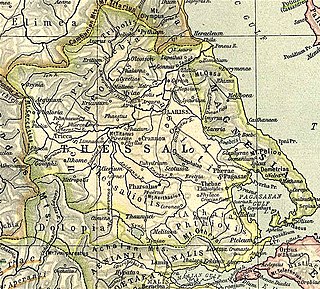Related Research Articles


Pythion or Pythium, also Pythoion (Πύθοιον) was a city and polis (city-state) of Perrhaebia in ancient Thessaly, situated at the foot of Mount Olympus, and forming a Tripolis with the two neighbouring towns of Azorus and Doliche. Pythion derived its name from a temple of Apollo Pythius situated on one of the summits of Olympus, as we learn from an epigram of Xeinagoras, a Greek mathematician, who measured the height of Olympus from these parts. Games were also celebrated here in honour of Apollo.

Doliche was an ancient Greek city and polis (city-state) in Perrhaebia in Thessaly, situated at the foot of Mount Olympus. Doliche, with the two neighbouring towns of Azorus and Pythion (Pythium), formed a Tripolis.


Condylon or Kondylon or Condylum or Kondylos was one of the four fortresses which defended the Vale of Tempe in ancient Thessaly. It was also called Gonno-Condylon, and was one of the towns of the Perrhaebi.


Theuma was a town of Ancient Thessaly near the frontiers of Dolopia. Livy relates that the retreat of Philip V of Macedon after the Battle of the Aous allowed the Aetolians to occupy much of Thessaly, and these latter plundered Theuma and nearby Celathara, whereas Acharrae surrendered.
Celathara was a town of Ancient Thessaly. Livy relates that the retreat of Philip V of Macedon after the Battle of the Aous allowed the Aetolians to occupy much of Thessaly, and these latter plundered Celathara and nearby Theuma, whereas Acharrae surrendered.
Cypaera or Kypaira or Cyphara or Cyphaera (Κύφαιρα) was a town and polis (city-state) of Ancient Thessaly, in the southern part of the district Thessaliotis or Phthiotis, near the confines of Dolopia. Livy relates that the retreat of Philip V of Macedon after the Battle of the Aous allowed the Aetolians to occupy much of Thessaly, and these latter, after sacking Xyniae took Cypaera. It has been located at a site called Palaia Yannitsou within the territory between the modern villages of Kaitsa and Makrirrachi (Μακρυρράχη), in the municipal unit of Xyniada.
Angeia or Angea was a town and polis (city-state) in ancient Thessaly in the district Dolopia. Livy relates that the retreat of Philip V of Macedon after the Battle of the Aous allowed the Aetolians to occupy much of Thessaly, and these latter devastated Angeia and its neighbour, Ctimene. Modern scholars identify the site of Angeia with the modern village of Loutropigi.






Sycurium or Syk[o]yrion was a town of ancient Thessaly in the district of Pelasgiotis, at the foot of Mount Ossa. Livy writes that during the Third Macedonian War, Perseus of Macedon encamped at Sycurium, between Mount Ossa and the lower Peneus; it overlooked the plains of Thessaly and was not far from Larissa.
Sperchiae or Sperchiai or Spercheiae or Spercheiai (Σπερχείαι) was a fortress in Ainis in ancient Thessaly, which, according to the description of Livy, would seem to have been situated at no great distance from the sources of the Spercheius. Ptolemy mentions a place Spercheia between Echinus and Thebes in Phthiotis; and Pliny the Elder places Sperchios in Doris. William Smith concludes it probable that these three names indicate the same place. Livy relates that the place was destroyed by the Aetolians in 198 BCE.
References
- ↑
 Smith, William, ed. (1854–1857). "Callithera". Dictionary of Greek and Roman Geography . London: John Murray.
Smith, William, ed. (1854–1857). "Callithera". Dictionary of Greek and Roman Geography . London: John Murray. - ↑ Livy. Ab urbe condita Libri [History of Rome]. Vol. 32.13.
- ↑ Mogens Herman Hansen & Thomas Heine Nielsen (2004). "Thessaly and Adjacent Regions". An inventory of archaic and classical poleis . New York: Oxford University Press. p. 679. ISBN 0-19-814099-1.
- ↑ Lund University. Digital Atlas of the Roman Empire.
![]() This article incorporates text from a publication now in the public domain : Smith, William, ed. (1854–1857). "Callithera". Dictionary of Greek and Roman Geography . London: John Murray.
This article incorporates text from a publication now in the public domain : Smith, William, ed. (1854–1857). "Callithera". Dictionary of Greek and Roman Geography . London: John Murray.
39°13′03″N21°59′18″E / 39.21753°N 21.98828°E